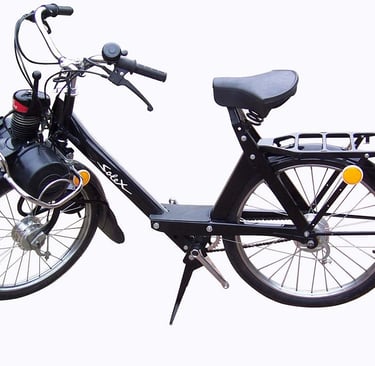VéloSoleX: The Iconic Journey of the Timeless Moped
The article discusses the history and evolution of the VéloSoleX moped, a motorized bicycle that originated in France in 1946. It covers the transition of the company Solex from manufacturing radiators to creating assist motors and bicycles. The moped gained popularity for its lightweight design and fuel efficiency. The article also mentions the changing ownership of Solex and the global impact of the VéloSoleX, with over 7 million units sold worldwide. It highlights the different models and modifications that were introduced over the years, as well as the moped's presence in popular culture. The article concludes by acknowledging the continued evolution of VéloSoleX, including its adoption of electric models, while maintaining its timeless charm and design.
CYCLEMOTORSTWO STROKEVINTAGE MOPEDSMOPEDSFRANCE1940'SVELOSOLEX
11/19/20232 min read


VéloSoleX: The Iconic Journey of the Timeless Moped
VéloSoleX, affectionately known as 'Solex,' holds a unique place in the hearts of moped enthusiasts worldwide. Originating from the renowned French manufacturer Solex, headquartered in Courbevoie near Paris, this motorized bicycle has a rich history, stretching back to its inception in 1946.
Evolution of a Marvelous Concept
Originally, Solex emerged from a company primarily involved in manufacturing centrifugal radiators, carburetors, and micrometers. The transition to assist motors and bicycles marked a turning point. The moped, conceived during World War II, retained its distinctive feature—a motor with a roller resting on the front wheel of a bicycle.
Known as the 'bicycle which drives itself' ("la bicyclette qui roule toute seule"), Solex gained immense popularity, especially among school children, students, and plant workers, owing to its lightweight design and exceptional fuel efficiency.
Changing Ownership and Global Impact
Under successive ownership by Dassault, Renault, and Motobécane/MBK, VéloSoleX achieved unprecedented success, with over 7 million units sold worldwide. The French production ceased in 1988, but the legacy endured. Post-1988, production revived in China and Hungary, only to return to France in 2005.
A Journey Through Models and Modifications
The Solex journey unfolds through a series of models and modifications:
1946: Introduction of a 45 cc model, setting the stage for future evolutions.
1959: Model 1700, featuring an automatic clutch and air cooling, revolutionizing the riding experience.
1966: Model S3800, the most common and widely sold version, bringing color to the frame and introducing the twist grip.
1971: Model 5000, with upgraded features and a range of vibrant colors, solidifying Solex's iconic status.
The innovation didn't stop there. From the 'Flash' in 1969 with disc brakes to the 2005 modernized version Black'n Roll S4800, Solex consistently adapted to changing times. Even in the electric era, Solex shines with models like 'e-Solex' and 'Solexity,' blending tradition with modern technology.
Solex in Popular Culture
VéloSoleX has made its mark in popular culture, appearing in films like "Mon Oncle," "The Boys from Brazil," and "Mr. Bean's Holiday." It has become more than a mode of transportation; it's a cultural icon.
As VéloSoleX continues to evolve, embracing electric models and captivating new generations, its timeless charm and distinctive design ensure that the legacy of this iconic moped remains firmly intact. For moped enthusiasts, VéloSoleX is not just a ride; it's a journey through history and a celebration of two-wheeled excellence.
